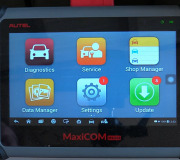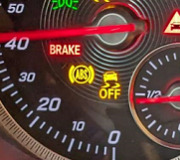Tone rings are the toothed wheels around the cv joint, hub, brake rotor, or drum that rotates with the wheel and tire. The sensor is a coil of wire wound around a magnet. Every time a tooth on the tone ring passes by the magnet, it disturbs the magnetic field. That "induces" a pulse of voltage into the coil of wire. It's those pulses that are counted by the Antilock Brake Computer and compared to the other three wheels to determine when one wheel is slowing down too quickly. When a tone ring cracks, it creates an extra pulse per tire revolution. That makes it look like the other three wheels are turning slower so the computer kicks in to reduce braking to them.
Some of the clues to help lead you to the problem include: If the ABS light comes on right after starting the engine, and before moving the car, suspect a sensor electrical problem or hydraulic actuator problem that was detected during the system self-test. If the warning light comes on only after the car has been moving, suspect a sensor mechanical problem causing it to read a wheel speed different than the other three wheels. This can include metal filings on the sensor's magnet, a cracked tone ring, or a completely cracked off and missing tone ring. These usually happen when water gets under them and freezes in winter causing them to crack. (Or in the case of one's mother getting her Grand Caravan stuck in the snow and spinning the wheels until the already-cracked tone ring breaks into a bazillion pieces)!
I've welded tone rings on my vehicles in the past, but only to prove to my students it is possible to weld cast iron. I've also replaced them, but you can't buy new ones. I remove them from half shafts in the salvage yards, then glue them in place with silicone RTV gasket sealer to keep the water out.
When the light does not come on, the computer accepts the readings it is getting from the sensors but is responding to extra pulses from one of them. The cracked tone ring, again, is the most common cause. If the brake pulsation continues after the vehicle is stopped, something is causing the pulses to continue. Misrouted spark plug wires can induce pulses magnetically into ABS sensor wires if they are too close together. That will make the computer think one wheel is still turning and the other three should be also. This is somewhat common on Ford trucks. Haven't really heard of it happening in other vehicles.
The ABS system should only be activating when you apply the brake pedal. If you feel it activate when the pedal is not pressed, suspect a computer problem or the pump is rebuilding used up hydraulic pressure. To determine if the pump is what you're hearing, turn the engine off, pump the brake pedal until it feels hard, then turn the ignition switch on. The pump should run for up to 20 seconds and the power assist should come back.
Caradiodoc
Thursday, April 15th, 2010 AT 2:01 PM



